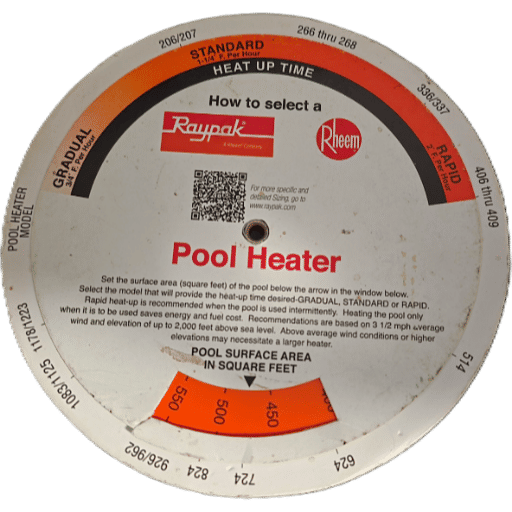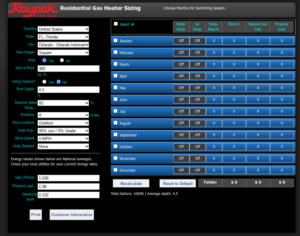
A gas pool heater is sized based on how long it takes to heat your pool. While there isn’t a difference between sizing a natural gas heater and a propane-based heater,
the factors that do affect how long it takes to heat your pool are:
- Pool surface area
- Desired swim temperature
- Ambient Temperature – What time of year will it be used?
- Desired rate of heat rise over time
- Will a solar blanket be used
How Big is My Pool?
The first step in sizing your heater is to calculate the surface area of your pool in square feet. To find the surface area of a rectangular pool, multiply the pool’s length by the width; for example, we’ll use an 18-foot by 36-foot rectangle. An 18ft by 36ft pool has a surface area of 648ft.
18 ft. x 36 ft. = 648 sq. ft.
Your Pool’s Surface Area = 648 sq. ft.
Minimum BTUs
Heaters are rated in British Thermal Units (BTUs), which is the notation for a pound of water being heated by 1 degree F. Dividing the surface area by 3 results in the minimum BTUs you need to heat the pool. In our example, you would need a minimum of 216,000 BTUs.
648 sq. ft. ➗ 3 = 216
216 x 1,000 = 216,000
Minimum Required BTUs for Your Pool = 216,000 BTUs
Even though this is the minimum amount of BTUs needed to heat the pool, that doesn’t mean it’s the best course of action. Now that we have a baseline, what other factors affect heater sizing?
Time to Heat
The bigger the pool, the longer it takes to heat, but that doesn’t mean we always have the patience to wait. Upsizing the heater decreases the amount of time it takes to heat a pool.
To calculate how long it takes to heat your pool:
- Subtract the average air temperature for your area from your desired air temperature for the degree difference.
- Take the gallon size of your pool, and multiply it by 8.34. This is how many pounds of water is in your pool.
- Divide the pounds of water in your pool by the minimum BTUs to determine how many hours it will take to heat it by 1 degree Fahrenheit.
- Now take your degree difference and multiply it by the hours taken to heat your pool by 1 degree. This results in how many hours it would take to heat the pool to your desired temperature.
For example, our 18×36-foot pool has an average depth of 5 feet. The formula to find the gallon size of our pool is Length times Width, multiplied by the average depth, and then multiplied one more time by 7.5
The calculations look like this:
- 85 – 70 = 15 degree difference
- 18 x 36 = 648sqft
648 x 5 = 3,240sqft
3,240 x 7.5 = 24,300gal
24,300 x 8.43 = 202,662lbs - 202,662 ➗ 216,000 = 0.93825 hours to heat 1 degree Fahrenheit
- 0.93825 x 15 = 14.074 hours to heat your pool
So for our 18×36-foot pool, it would take approximately 14 hours to heat to our desired temperature with the minimum BTUs. It would take too long if we only run our pump 8-10 hours a day, so how do we find what size is better for our needs?

I understand doing the calculations yourself may not be everybody’s jam, but there is still a way for everyone to calculate what they need. Raypak has a handy online calculator where you can input information, hit a button, and boom: free recommendations on what size heater you should buy!
Doing the Math
If you decide to do the math yourself, I have a 2-step formula that finds how many BTUs you need.
- Take your desired hours to heat, and divide it by your degree difference.
- Divide the pounds of water in your pool by the number you found in step one. That is how many BTUs you need for your specifications.
In our example, we will give the heater 9 hours to heat to the desired temp. The calculations are:
- 9 ➗ 15 = 0.6
- 202,662 ➗ 0.6 = 337,770 BTUs
Based on that, the best heater for our pool would be 399,000 BTUs.
Why Get a Solar Cover?
A solar cover works wonders for keeping heat in your pool because it stops heat from escaping overnight when it’s cold and dark. If you were deciding between a 250,000 BTU heater and a 300,000 BTU one, you could choose the smaller size and a solar cover to save some money.
Credit : Source Post






